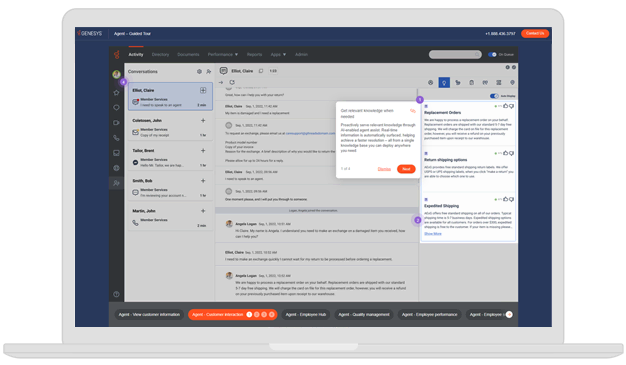Contact center shrinkage is the percentage of paid staff time that agents are unavailable to handle customer interactions — due to breaks, training, meetings or unplanned absences. It helps leaders calculate the gap between total scheduled hours and actual productive time. Understanding what shrinkage in call centers means is key to accurate staffing and consistent service delivery.
“With native predictive and prescriptive AI built on proprietary AI models, you can more easily align staffing plans with long-term demand by understanding attrition percentage, or shrinkage, along with full-time equivalency expectations. These insights are essential to developing right-sized hiring plans for the next year, next season, event or launch.”
Jim Nies, Vice President of Product Management, Genesys
Enterprise use cases of contact center shrinkage
Forecasting staffing needs with greater accuracy
Organizations use call center shrinkage metrics to refine workforce forecasting. By factoring in scheduled and unscheduled time away, leaders determine the real number of agents required to meet demand. This prevents overstaffing during low-volume periods and under-resourcing during peaks — two common causes of poor customer experiences and excessive labor costs.
Optimizing workforce planning and scheduling
Workforce management tools integrate call center shrinkage calculators to automate staffing models. Enterprises apply the shrinkage formula to create efficient schedules that balance employee availability with business demand. The result: better agent utilization, reduced idle time and consistent adherence to service-level targets.
Benchmarking operational efficiency across sites
Enterprises compare call center shrinkage benchmarks across teams and geographies to assess operational performance. High shrinkage rates may signal scheduling inefficiencies, engagement challenges or lack of flexibility. By identifying patterns, contact center leaders can implement targeted interventions — like flexible shifts or enhanced engagement programs to improve productivity.
Enhancing employee experience through transparency
Tracking shrinkage in call centers isn’t just about efficiency — it’s also about fairness. Transparent metrics help agents understand how their time contributes to business goals and performance outcomes. This clarity builds trust and encourages collaboration between management and frontline staff, improving engagement and retention.
Reducing hidden costs through continuous monitoring
Unmanaged call center shrinkage often results in increased overtime, longer wait times and missed SLAs. Enterprises that monitor shrinkage proactively use real-time analytics to identify trends, prevent burnout and optimize resource allocation. Over time, this leads to measurable cost savings and stronger customer loyalty.
Reduce contact center shrinkage with Genesys
Genesys solutions empower enterprises to predict, manage and reduce call center shrinkage using AI-powered forecasting and real-time workforce insights. Achieve higher efficiency, happier agents and faster response times — without sacrificing quality.
Explore Genesys Cloud Workforce Engagement Management ›






